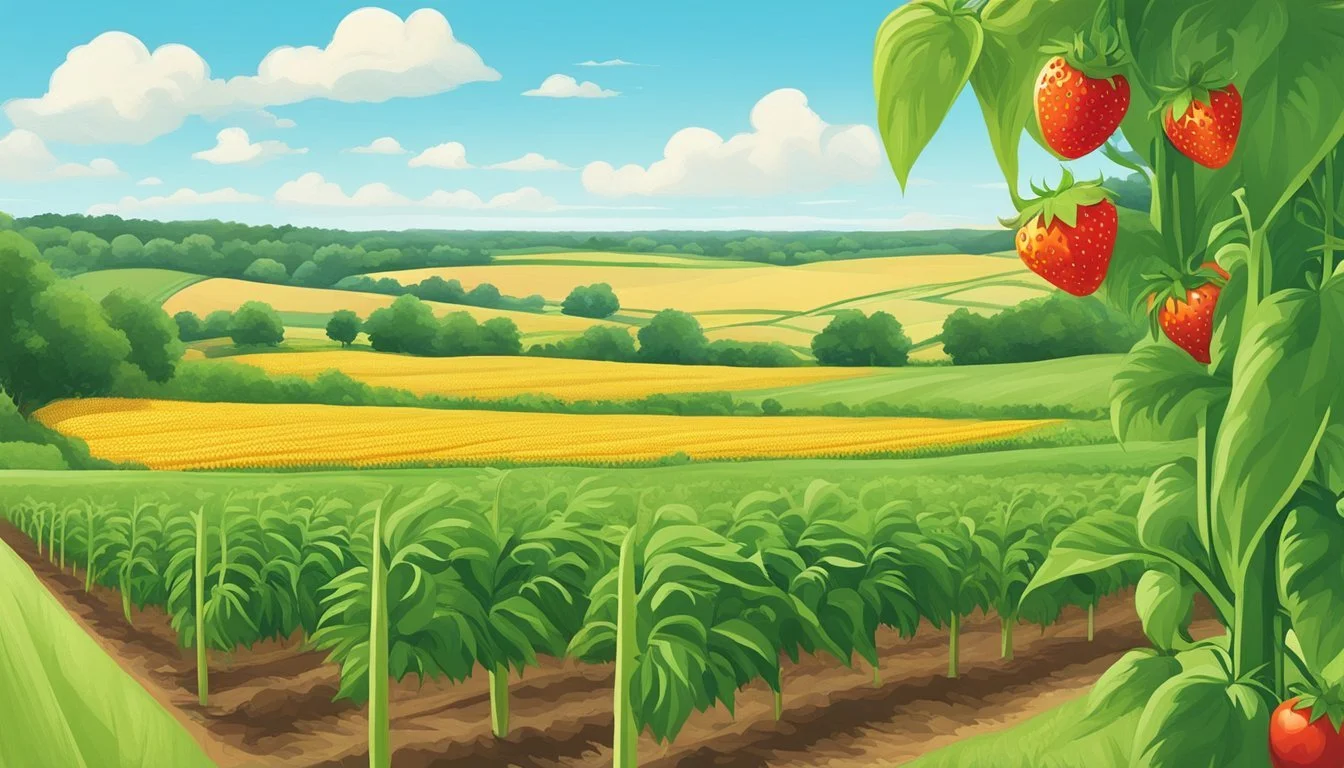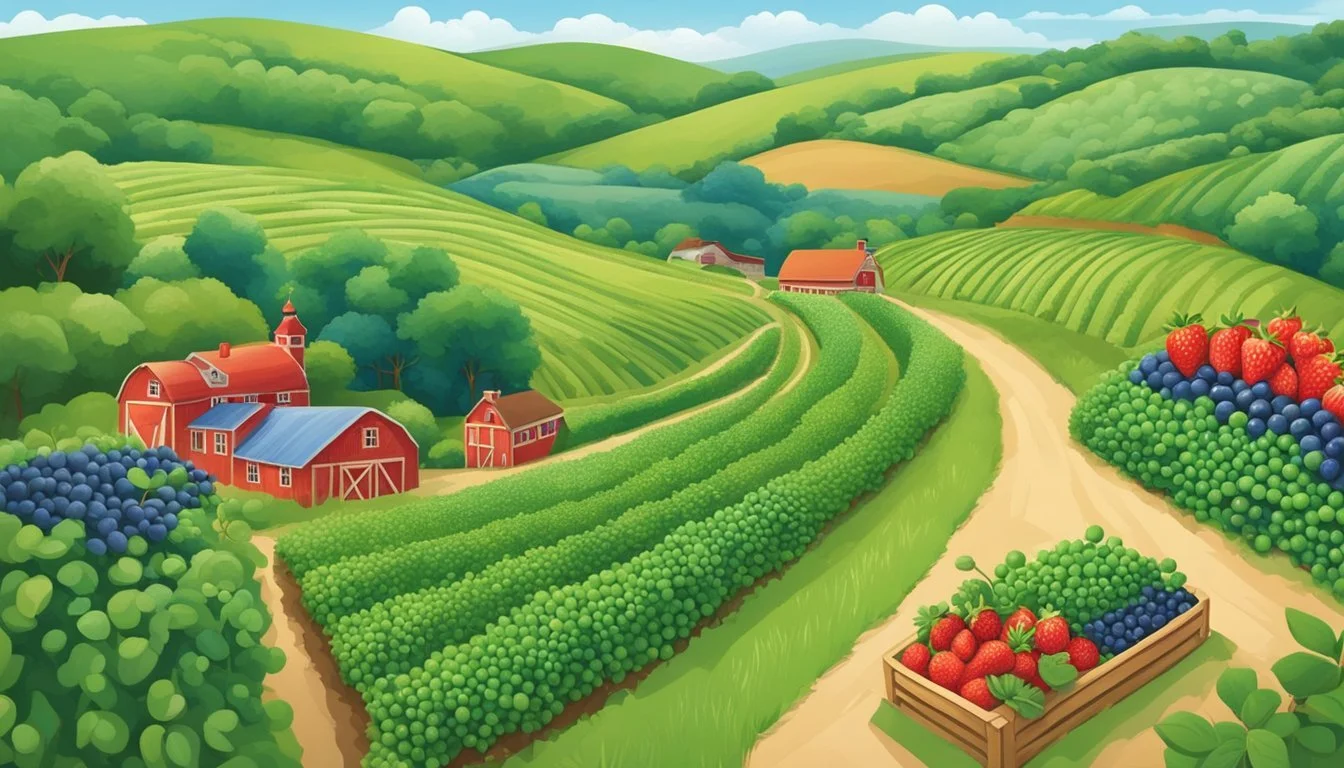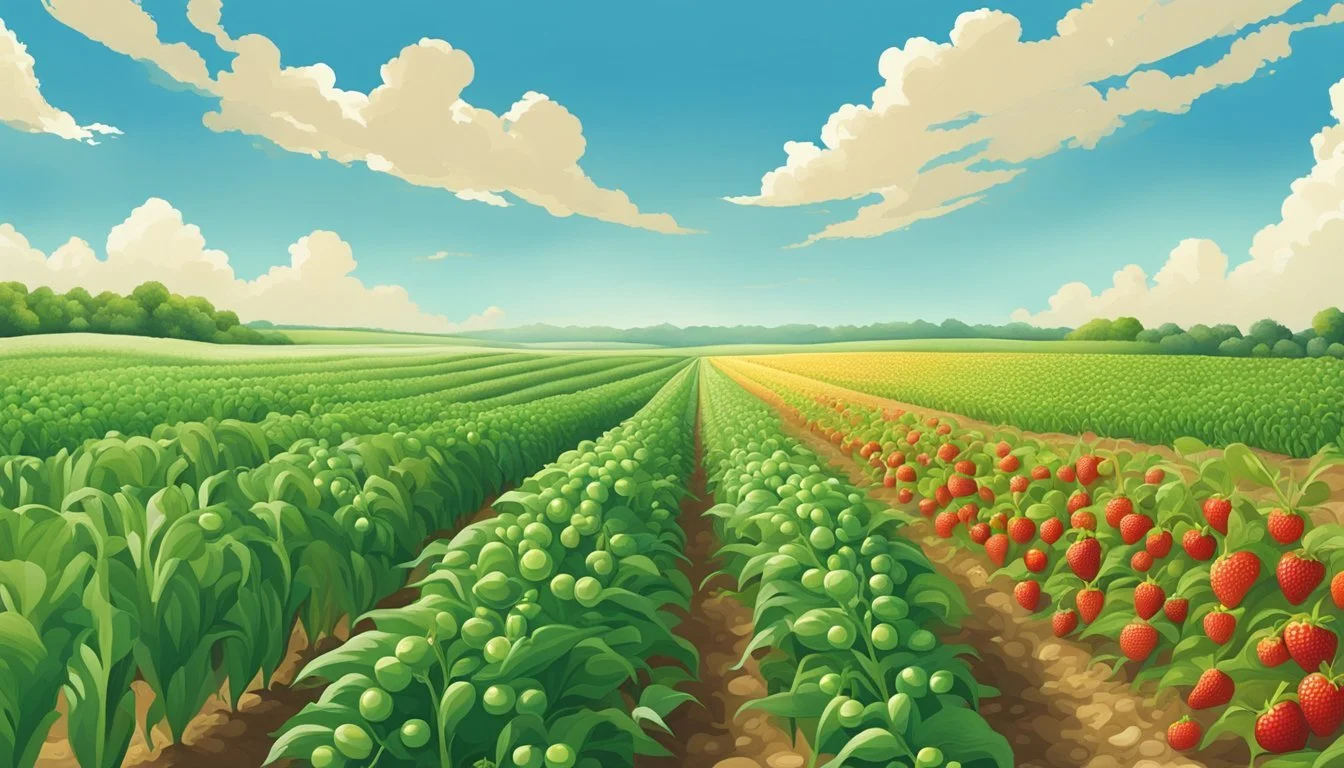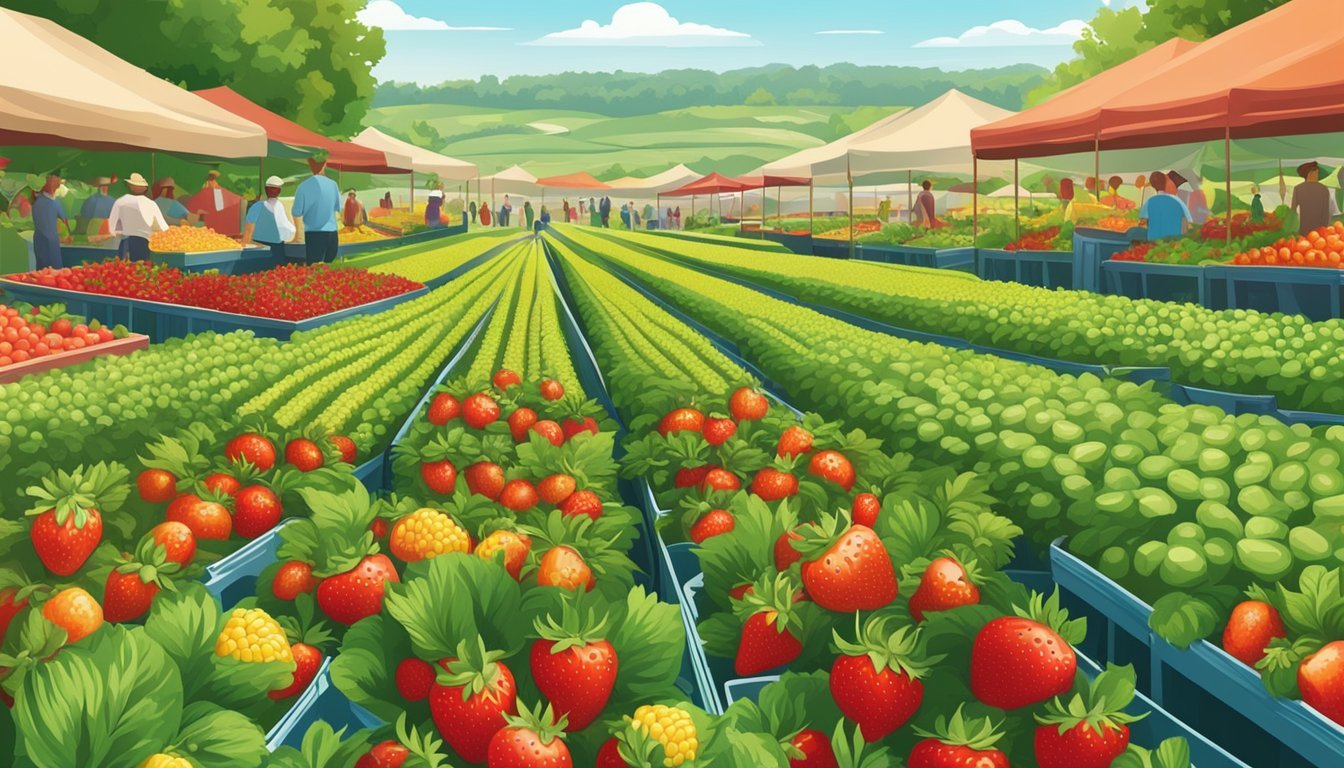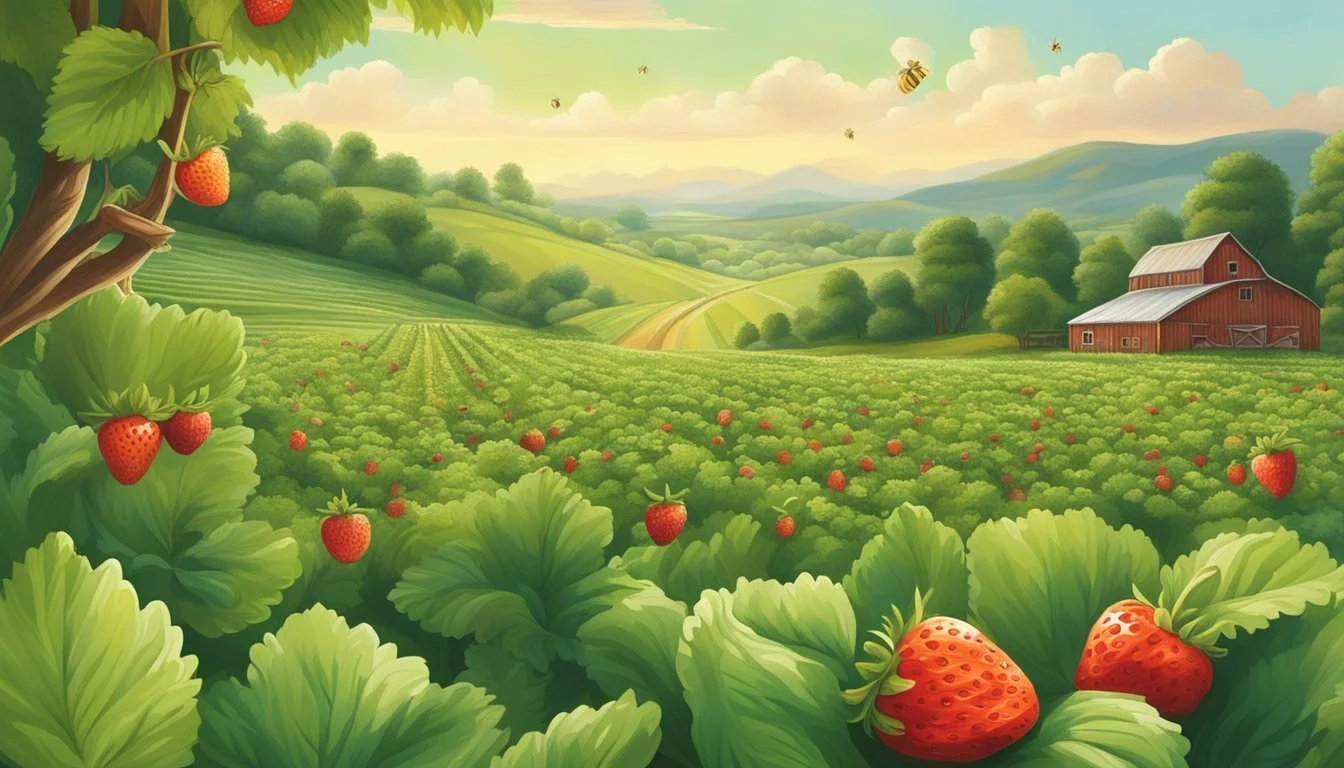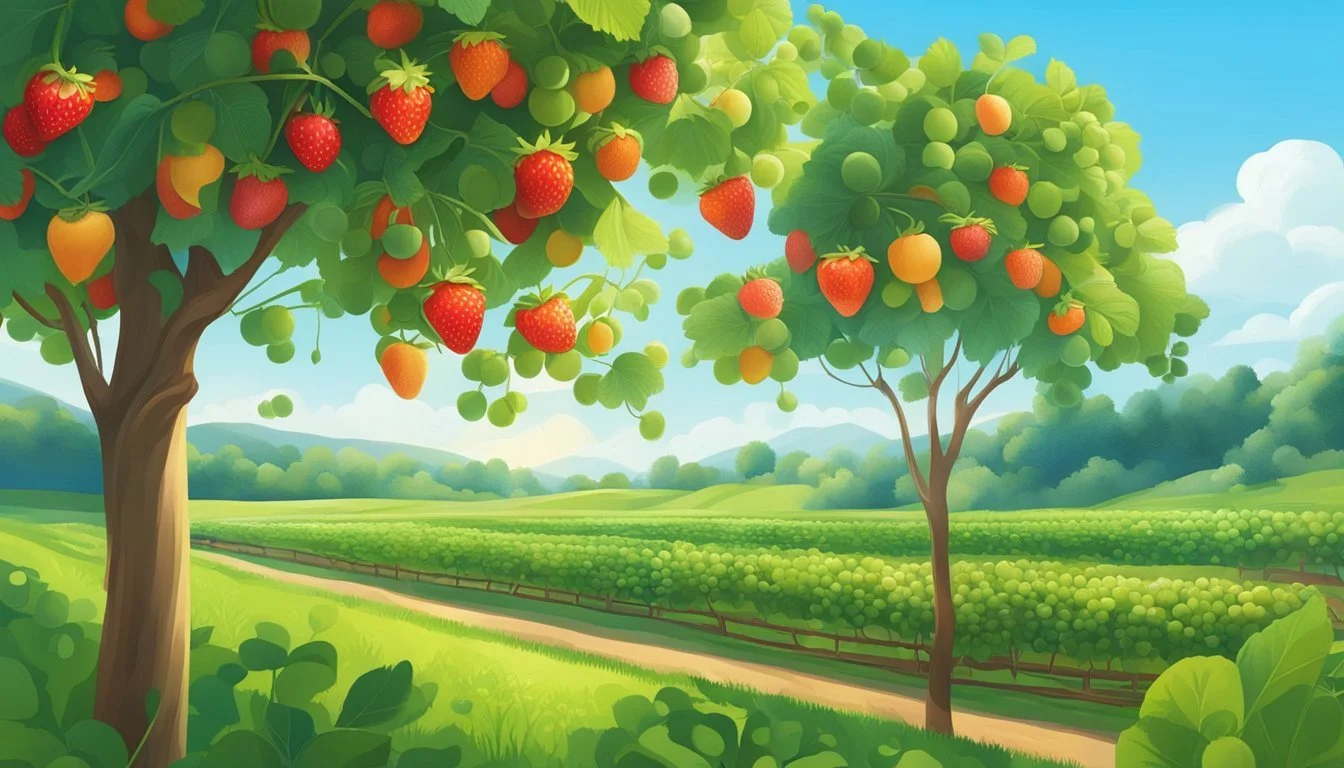Iowa Seasonal Fruit & Vegetables in June
Your Fresh Produce Guide
This Article is Part of our Iowa Seasonal Fruit & Veg Calendar
As June arrives, Iowa's fields and gardens begin to offer a bounty of fresh produce. This month marks a transition period where late spring crops overlap with early summer harvests, providing a diverse variety of fruits (What wine goes well with fruit?) and vegetables. Iowans and visitors alike look forward to the fresh, locally grown options that become available at farmers markets, roadside stands, and in their own backyards.
The summer climate in Iowa, characterized by warm temperatures and adequate rainfall, creates an ideal environment for growing an array of produce. Farmers in the state take pride in their sustainable and efficient agricultural practices that result in high-quality, nutritious fruits and vegetables. Among the summer offerings, residents anticipate the arrival of sweet corn (how long does corn last?), a staple in the Iowa diet, while strawberries begin to wind down after their peak in late spring.
With a focus on farm-to-table eating, consumers are not only enjoying seasonal flavors but also supporting the local economy. June in Iowa brings the freshest greens, beans, and a multitude of fruits and vegetables to the table, all celebrated for their freshness and flavor. This month sets the stage for a summer filled with the best of what Iowa's rich soil has to offer.
Iowa's Seasonal Growing Calendar
In the context of Iowa's seasonal produce calendar, June marks a dynamic period within the state's unique agricultural makeup. Iowa, sprawling across USDA Hardiness Zones 4b to 5b, presents a variety of climatic conditions fostering a diverse range of crops.
Spring transitions into summer in June, bridging the gap between delicate early harvests and the robust bounty characteristic of full summer. Gardeners and farmers in Iowa are prepared to collect the harvests that thrive in this warm month.
Here is a simplified table covering key fruits and vegetables that are typically harvested in Iowa during June:
Fruits Vegetables Strawberries Lettuce Raspberries Radishes Spinach Kale Peas Beets Broccoli Cauliflower Kohlrabi Carrots
As the state progresses into summer, residents and farmers alike can expect an increase in locally sourced fruits such as strawberries and raspberries, known for their fresh, tangy flavors and nutritional benefits.
The vegetables that reach maturity in June are typically those planted in early spring, including leafy greens like lettuce and spinach which are best harvested before the summer heat intensifies. Root vegetables and cruciferous options like radishes, beets, and broccoli add to the variety available in markets and farm stands across Iowa.
Heading into fall, these crops will give way to late-season yields; however, in June, the focus is undeniably on the vibrant, fresh produce characteristic of early summer in Iowa. Notably, the knowledge of these seasonal patterns allows for anticipation of the freshest local produce, ensuring culinary experiences are optimally aligned with what the season affords.
Selecting the Right Fruits and Vegetables
In Iowa, June marks the arrival of a diverse array of fresh produce, each offering its own distinct flavor and nutritional benefits. It's the ideal time to indulge in the vibrant colors and tastes of the season's fruits and vegetables.
Berries in Bloom
June in Iowa is a prime month for berries. One can find strawberries bursting with sweetness, perfect for jams or just enjoying fresh. Raspberries and blackberries also make their appearance, adding a tart yet delicious option to the fruit selection.
Stone Fruit Season
Though still early, some cherries might start to make their way to markets, a herald of the stone fruit season. Expect the early varieties to offer a balance between sweetness and a hint of tanginess.
Melons and More
The start of watermelon and cantaloupe (how long does cantaloupe last?) season hints at the approaching summer. Their refreshing moisture and sweetness make them an ideal choice for staying hydrated and satisfying a sweet tooth.
Versatile Vegetables
Tomatoes, peppers, and leafy greens like lettuce, kale, and spinach are in abundance. These vegetables not only add flavor to meals but also provide a variety of nutrients that are essential for a balanced diet.
Root Vegetables and Legumes
Carrots and potatoes are staples that continue to be available, alongside early peas and onions, offering an earthy flavor profile and versatility in cooking.
Squash and Gourds
Zucchini and other summer squashes begin to flourish, ready for grilling, sautéing, or incorporating into baked goods for added moisture and nutrition.
Sweet Corn Harvest
The much-anticipated corn season starts in late June, bringing with it the irresistible taste of fresh, sweet kernels that are synonymous with Iowa's agricultural heritage.
Orchard Offerings
Early varieties of apples may start to surface towards the end of the month, hinting at the diverse selection to come. Their crispness and subtly sweet tang make them a coveted fruit for fresh eating and baking alike.
Unique Produce Varieties
Other unique varieties like cucumbers, eggplants, and broccoli also become available, offering a range of textures and flavors to explore in creative culinary endeavors.
Cultivation Tips for Iowa's Climate
Iowa's climate challenges gardeners with its temperature variations and distinct seasons. An understanding of local conditions, strategic planting techniques, and diligent care is crucial for a bountiful garden.
Understanding Soil and Sunlight
Iowa falls predominantly in the USDA Hardiness Zones 5a to 5b, which dictates the types of plants suited to the region's conditions. Soil in Iowa's gardens should be nutrient-rich and well-draining. Sunlight is abundant during the growing season, with most vegetables requiring full sun, defined as six to eight hours of direct sunlight per day.
Soil Preparation: Enhance soil with compost or aged manure to improve fertility.
Sunlight: Ensure garden beds receive ample light, considering the sun's path throughout the season.
Planting Techniques
Gardeners should adapt their planting techniques to the region's climate. Vertical gardening can be an effective method to maximize space and reduce pest access.
Vertical Gardening: Utilize trellises and cages for crops like tomatoes and cucumbers.
Succession Planting: Sow seeds at intervals to extend the harvest window and mitigate risk.
Managing Pests and Diseases
Pests such as Japanese beetles, aphids, and bigger wildlife like deer, rabbits, and squirrels pose threats to Iowa gardens. Diseases often follow suit given favorable conditions for infection.
Pest Control: Regularly inspect plants and implement physical barriers or repellents.
Disease Prevention: Choose disease-resistant varieties and practice crop rotation to minimize risks.
Watering and Weather Protection
Variable weather with instances of heat and drought requires gardeners to be attentive to their plants' water needs. Consistent and appropriate watering ensures plants remain healthy and productive.
Irrigation: Employ soaker hoses or drip systems for deep, even watering that conserves water.
Mulching: Apply mulch around plants to retain moisture and regulate soil temperature.
Post-Harvest Handling and Storage
After harvesting, the quality and safety of fruits and vegetables can be significantly preserved through proper post-harvest handling and storage. To maintain the freshness and flavor of Iowa’s seasonal produce in June, efficient methods are crucial.
Cleaning and Sorting: Initial cleaning can help remove field dirt and potential contaminants. Sorting is also an important step to separate damaged or diseased produce which can affect the rest of the harvest.
Quick Cooling: To retain the crispness and flavor, quick cooling is recommended. Methods include hydrocooling for items like strawberries and forced air cooling for sweet corn.
Packaging: Correct packaging ensures protection against physical damage and can extend shelf life. Iowa State University Extension recommends using materials that provide adequate ventilation and protect the produce from excess moisture.
Refrigerated Storage:
Temperature: Fruits and vegetables should be stored at their optimum cold storage temperature to slow down respiration and degradation.
Humidity: High relative humidity levels are generally preferred to minimize water loss and wilting.
Freezing: Freezing is an excellent way to preserve the flavor and nutritional value of produce. This process is ideal for berries and sweet corn. However, it is essential to blanch vegetables like green beans before freezing to retain quality.
Transportation: The use of refrigerated transportation ensures the cold chain is maintained from the farm to the market or end consumer, which is pivotal in preserving the integrity and taste of the produce.
By following these guidelines, producers and handlers can extend the shelf life of fruits and vegetables and maximize their market value.
Local Agricultural Events
In Iowa, June signifies a season rich with agricultural events that showcase the state's robust farming heritage and community spirit. These events offer an array of experiences from market fresh produce to traditional fair festivities.
Farmers' Markets
Farmers' markets across Iowa serve as a pivotal gathering place for local growers to sell their fresh produce. Notable markets such as the Des Moines Farmers' Market provide a wide selection of seasonal fruits and vegetables, attracting visitors from various cities and towns.
Cities Known for Farmers' Markets:
Des Moines
Cedar Rapids
Iowa City
Community Supported Agriculture (CSA)
Community Supported Agriculture programs see heightened participation during June. Iowans can subscribe to receive a regular share of fresh produce directly from local farms. This initiative not only bolsters the agricultural economy but also fosters a direct farmer-consumer relationship.
Example CSA Farms:
Harvestville Farm
Grade A Gardens
Buffalo Ridge Orchard
Agricultural Fairs and Expositions
The state hosts several agricultural fairs and expositions in June. These events often feature competitions, educational exhibits, and showcases of Iowa's top crops. The Iowa Department of Agriculture and Land Stewardship (IDALS) may participate or support these fairs, emphasizing the importance of agriculture in the state.
State Involvement:
Iowa Department of Agriculture and Land Stewardship (IDALS) engagement
Corn Mazes and Fall Festivities
While corn mazes are traditionally a hallmark of autumn, planning and design often begin in June. Iowa's farms, known for their extensive corn production, prepare these mazes to be ready for the fall season, providing both an educational and recreational harvest-time activity.
Popular Corn Farm Locations:
North River Corn Maze
Bloomsbury Farm
Pierce's Pumpkin Patch
Supporting Iowa's Food Ecosystem
In Iowa, the month of June marks a flourishing period for the local food ecosystem, where a movement towards supporting community-driven agriculture gains momentum. The act of purchasing fruits and vegetables in season reinforces the agricultural community. Iowa's produce calendar reveals that June invites a bounty of fresh options such as strawberries and leafy greens.
Local farmers' markets become vibrant hubs of activity, showcasing the freshest seasonal produce. These markets play a critical role in empowering small-scale farmers, fostering a thriving community-centric economy. This dynamic aids in circulating money within local borders, securing economic resilience.
Seasonal Produce Available in June:
Fruits: Strawberries, Blueberries
Vegetables: Lettuce, Spinach, Radishes
Through purchasing locally, residents contribute significantly to Iowa's economy. The governor's declaration of Iowa Fruit and Vegetable Week in June underscores this commitment, celebrating horticulture's $48 million contribution to the economy.
Participation in this local food system not only bolsters the state's economy but also ensures sustainability. Organizations like the Sustainable Iowa Land Trust (SILT) advocate for the preservation of farmable land around urban centers, reinforcing the local ecosystem's infrastructure.
Through these combined efforts, the support for Iowa's food ecosystem becomes clear, affirming the state's dedication to agricultural community, local prosperity, and a robust economy.
Conclusion
June in Iowa presents a vibrant array of fresh fruits and vegetables, with the local growing season in full swing. Residents and visitors have the opportunity to indulge in the freshest produce, with a focus on sustainability and community support.
Fruits Available:
Cherries
Vegetables Available:
Lettuce
Radishes
Spinach
Kale
Produce availability can vary depending on specific regional climates and weather conditions. It is wise for consumers to reach out to local farms for the most current information regarding crop availability. Purchasing in season not only ensures peak flavor and nutrition but also supports Iowa's agricultural economy.
Farmers' markets become bustling centers of activity, showcasing the state's agricultural diversity. They offer a platform for farmers to connect directly with the community, providing education on seasonal eating and the advantages of locally-sourced food.
In summary, June in Iowa flourishes with a selection of produce that contributes to healthy eating patterns and fosters local food systems. It's a prime time for individuals to explore the rich tapestry of Iowa's horticulture.

